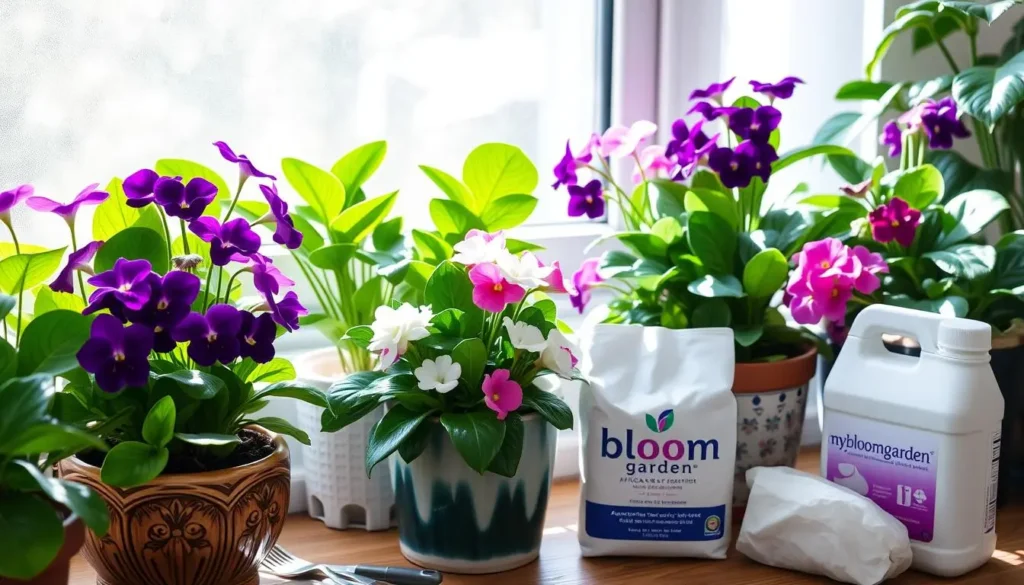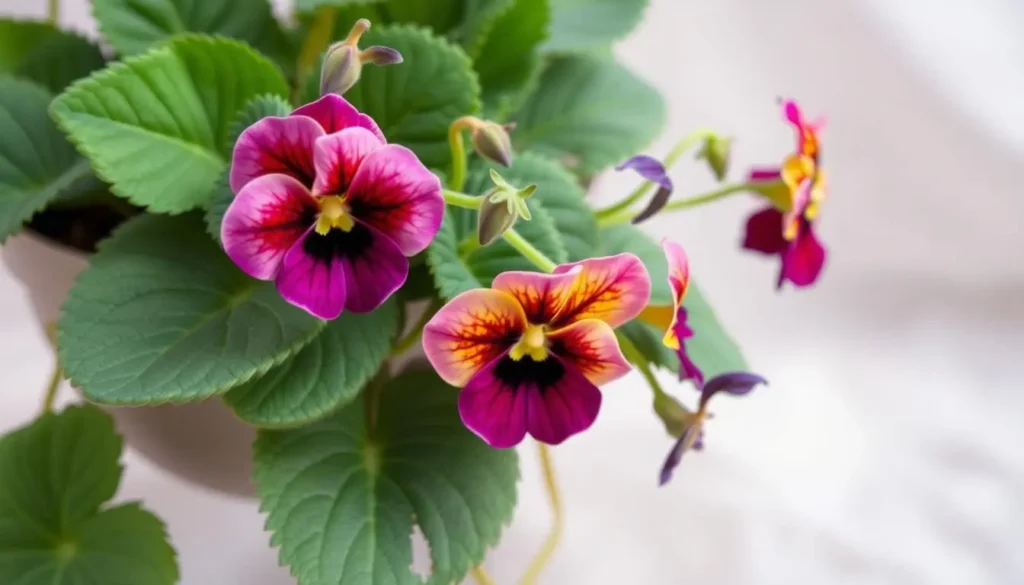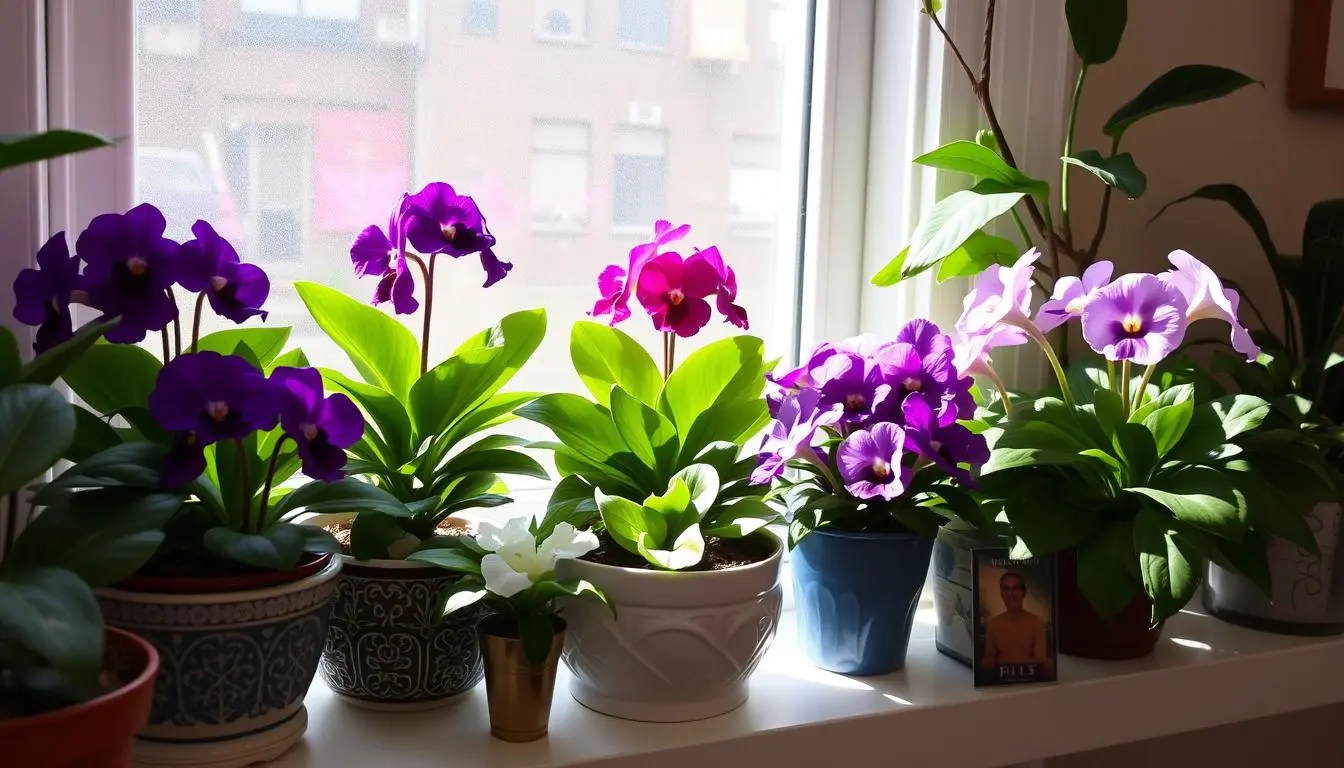Imagine a burst of color on your windowsill, with delicate blooms swaying in the sun. This is what African violets bring to your home. They are loved by gardeners everywhere, whether you’re new or experienced.
I love African violets for the joy they add to my home. They fit well in any space, from small windowsills to big sunrooms. But, they need special care to grow well.
In this guide, I’ll share tips to help your African violets grow. You’ll learn about their needs and how to propagate them. With the right care, you can enjoy these beautiful flowers at home.
Table of Contents
Understanding African Violet Basics
Discover the fascinating origins and captivating varieties of the beloved african violet flower. These enchanting plants have their roots firmly planted in the vibrant landscapes of East Africa. They thrive in the region’s lush, tropical environments. With a diverse array of african violet purple blooms, african violet flowers, and unique growth characteristics, these resilient african violet plants have captured the hearts of gardeners around the world.
Native Origins and Natural Habitat
The african violet, scientifically known as Saintpaulia, is indigenous to the eastern regions of Africa, particularly Tanzania and Kenya. In their natural habitat, these plants flourish in the understory of tropical rainforests. They are sheltered from direct sunlight and thrive in the warm, humid conditions.
Popular Varieties and Colors
Over the years, the cultivation and hybridization of african violets have led to the development of a vast array of captivating varieties. From the classic single-bloom violet to the regal double-bloom varieties, the african violet flower comes in a vibrant spectrum of colors. This includes shades of purple, pink, white, and even bicolor combinations.
Growth Characteristics
African violets are known for their distinctive growth habits. They form a compact, rosette-like structure with broad, velvety leaves that emerge from a central crown. The african violet plants produce delicate, bell-shaped blooms that appear in clusters. These blooms enchant the senses with their delicate fragrance and eye-catching hues.
“The african violet is a true treasure, a plant that captivates with its timeless beauty and resilience.”
Essential Light Requirements for Thriving African Violet Plants
Delightful african violet plants bring joy to our homes. They need the right amount of light to thrive. Knowing their light needs is crucial for healthy houseplants.
African violets love bright, indirect sunlight. They do best near sunny windows but not in direct rays. They need 12-14 hours of bright, diffused light daily. If natural light is scarce, artificial lights can help.
- Fluorescent or LED grow lights work well, positioned 12-15 inches above the plants.
- Time the lights to provide the recommended daily light exposure.
- Monitor for signs of too much or too little light, adjusting as needed.
Too much direct sunlight can burn african violet leaves. Not enough light makes them grow too long and bloom less. Watch your plants closely and adjust the light to keep them healthy and colorful.
“The secret to growing healthy african violets is providing the right amount of light – not too much, not too little.”
By understanding and meeting your african violet plants’ light needs, you’ll enjoy a beautiful show of african violet flowers. They will brighten up any room.
Optimal Temperature and Humidity Conditions
Keeping the right temperature and humidity is key for your african violet plants’ health. These plants love a certain indoor setting to grow well.
Creating the Perfect Indoor Environment
African violets do best in temperatures between 65°F and 75°F (18°C to 24°C). Don’t let them face sudden temperature changes. Extreme heat or cold can stress them and slow their growth.
Humidity Management Techniques
- Use a pebble tray: Fill a shallow tray with pebbles and water, then place your african violet pot on top. As the water evaporates, it increases the humidity around the plant.
- Mist the leaves regularly: Use a clean spray bottle to mist the foliage of your african violet plants, especially during drier months.
- Consider a humidifier: If your indoor environment is particularly dry, a small humidifier can help maintain optimal humidity levels for your african violet houseplant.
Seasonal Care Adjustments
Change your care routine with the seasons. In winter, when air is drier, boost your humidity efforts. In summer, watch out for too much heat and provide shade if needed to protect your plants.
“Proper temperature and humidity are essential for the long-term health and blooming of african violet plants.”
Soil and Potting Requirements for African Violet
Starting a healthy African violet plant begins with the right soil and pot. These plants love soil that drains well and is full of nutrients. For pots, choose something shallow and wide. This lets the roots spread out comfortably.
For the best soil mix, look for one with:
- Peat moss or organic matter to hold moisture and give nutrients
- Vermiculite or perlite for better drainage and air
- A bit of lime to keep the soil slightly acidic, which violets like
When you need to repot, pick a container just a bit bigger than the old one. Big pots can cause water to pool and harm the roots. Carefully move the plant, water it well, and avoid damaging the roots.
Repotting frequency depends on how fast your plant grows. Generally, repot every 12-18 months. This helps your violet plant stay healthy and bloom brightly.
“The key to successful african violet growing lies in providing the right soil and potting conditions – it’s the foundation for a flourishing plant.”
By following these tips, you’ll help your African violet plant thrive in your home.
Watering Techniques and Common Mistakes
Proper watering is key for your african violet houseplant to stay healthy. Bottom watering is a great method. It prevents soil compaction and ensures moisture is evenly spread.
Bottom Watering Methods
To bottom water your african violets, put the pot in a shallow tray or saucer with water. Let the soil soak up moisture from the bottom. Make sure the leaves don’t get wet. This helps the roots grow strong and healthy.
Water Temperature Considerations
The water temperature for your african violet matters. Use lukewarm water. Cold water can shock the plant, causing leaf discoloration or stunted growth.
Signs of Improper Watering
Too much or too little water can harm your african violet. Overwatering leads to yellow or wilted leaves. Underwatering causes dry, brittle, and curled leaves. Watch your plant closely and adjust your watering as needed.
“Watering your african violet correctly is one of the most important aspects of keeping it healthy and thriving.”
Mastering bottom watering and the right water temperature is crucial. It ensures your african violet gets the right amount of water to thrive.
Fertilizing Your African Violet Plants
Proper fertilization is key for your african violet plants to stay lush and bloom well. A balanced approach is best for these delicate houseplants. Let’s look at the best ways to feed your african violet flowers and help them thrive indoors.
Choosing the Right Fertilizer
Choose a fertilizer made just for african violets. These have a balanced mix of nutrients, like 20-20-20 or 14-12-14. Don’t use regular all-purpose fertilizers, as they might not give your plants the right nutrients.
Frequency of Fertilization
- Feed your african violet plants every 2-4 weeks with a weak solution during the growing seasons (spring and summer).
- In the fall and winter, when they grow slower, fertilize once a month or every 6-8 weeks.
- Always check the fertilizer package for the right amount to use.
Watch for signs of nutrient needs or too much fertilizer. This will help you adjust how often and what you feed your plants.
Recognizing Nutrient Needs
Yellow leaves, slow growth, and poor blooms mean your plants might need more nutrients. Too much fertilizer can harm leaves, roots, and even kill the plant. Change your feeding schedule and type to keep your plants healthy and vibrant.

“Proper fertilization is the key to unlocking the full potential of your african violet plants.”
Understanding your african violet flowers’ nutritional needs and using a balanced feeding plan will help them grow well. This way, they’ll add beauty to your home for many years.
Pruning and Maintenance Guidelines
Keeping your african violet plants healthy and looking good needs a mix of pruning and grooming. By sticking to a few easy steps, your purple african violet plants will flourish. They will keep showing off their bright blooms.
Removing Dead Blooms and Leaves
It’s key to regularly remove spent flowers, or deadhead, to keep your african violet plants blooming. When the flowers start to fade, gently pinch or cut them off at the base. Be careful not to hurt the leaves. This not only makes the plant look better but also helps it grow new, healthy flowers.
Also, watch for yellow, wilted, or damaged leaves and take them off right away. Use clean, sharp scissors to cut the leaves close to the soil. Getting rid of these leaves keeps your plant looking neat and stops diseases from spreading.
Crown and Sucker Management
- Keep the african violet’s rosette shape by gently trimming any leaves that get in the way.
- Look out for suckers, or small plants, growing at the base. Remove them to stop them from taking over and messing with the main plant’s growth.
- Use your fingers or clean, sharp scissors to carefully pull off the suckers. Make sure to get the whole stem and roots.
By following these pruning and care tips, you can keep your african violet plants in top shape. They will keep blooming and thriving for many years.
Propagation Methods and Tips
Propagating african violet plants is a fun way to grow more of these lovely plants. You can make new plants from the leaves of your current ones. This is a popular method.
To start, pick a healthy, big leaf from your plant. Take the leaf off carefully, making sure you get a bit of stem too. Then, put the stem in rooting hormone powder to help it grow roots. Plant the cutting in a mix that drains well and is clean.
- Put the cutting in a humid, warm place, like a covered container or a tray with a clear lid.
- Water the soil a little, keeping it moist but not too wet.
- Put the container in a bright, indirect light spot, but not in direct sunlight.
- Check the cutting often. In a few weeks, you’ll see new plants growing from the leaf base.
When the new plants have strong roots, you can move them to their own pots. Give them the same care as your big plants. Watch them grow and bloom beautifully.
“Propagating african violets is a rewarding way to expand your collection and share these beautiful plants with others.”
By following these easy steps, you can grow more african violet plants. With a bit of patience and care, your home will soon be filled with their vibrant colors and lovely blooms.

Troubleshooting Common Problems and Diseases
Starting your journey with african violet plants can come with some hurdles. You might face pests, leaf issues, and diseases. Knowing how to tackle these problems is key to keeping your plant healthy. Let’s explore the common issues and how to solve them.
Pest Management Solutions
Pests like spider mites, mealybugs, and thrips can harm your african violets. To fight these pests, try organic pest control or natural predators indoors.
Leaf Problems Diagnosis
Leaf problems, such as curling or discoloration, can occur. These issues might stem from bad watering, lighting, or nutrients. By watching your plants closely and finding the root cause, you can fix these problems.
Disease Prevention Strategies
African violets can also get fungal diseases like powdery mildew or root rot. To prevent these, keep your growing conditions right, stay clean, and take preventive steps. This will help your plant stay healthy for a long time.
“Troubleshooting common problems and diseases is a crucial aspect of growing healthy african violet plants. With the right knowledge and proactive measures, you can overcome these challenges and enjoy the beauty of your african violet houseplant for years to come.”
Conclusion
Caring for African violets is a rewarding hobby. You can create a beautiful indoor space with these plants. They need the right light and water to thrive.
Pay attention to the details to grow stunning African violets. Troubleshoot any problems and use the propagation methods shared. This way, you’ll enjoy their beauty for years.
Now you’re ready to grow vibrant African violets at home. Let them add elegance to your space. Happy gardening!

